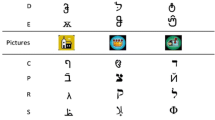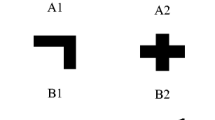Abstract
This experiment examined the whole-partial effect of overtraining in concurrent discriminations using two different sensory modality tasks (tactual and visual task) and assessed the effect against single discrimination training in rats. Overtraining facilitated reversals in both Group W, in which rats were given concurrent training on two tasks in the original learning before both tasks were reversed, and Group S, in which rats were trained only on the tactual task before it was reversed. Overtraining retarded reversal in Group P, in which rats were given the same training as in Group W in original learning, but only the tactual task was reversed. After overtraining, Groups Wand S reversed more rapidly than Group P. After criterion training, Group P reversed more rapidly than Group W, which reversed more rapidly than Group S. These findings indicate that rats form stimulus classes (i.e., cross-modal stimulus classes) between the discriminative stimuli of two different sensory modalities with the same response assignment during overtraining in two concurrent discriminations as well as between the discriminative stimuli of the same sensory modality.
Similar content being viewed by others
References
BHATT, R. S., & WASSERMAN, E. A. (1989). Secondary generalization and categorization in pigeons. The Journal of the Experimental Analysis of Behavior, 52, 213–224.
DELIUS, J., AMELING, M., LEA, S. E. G., & STADDON, J. E. R. (1995). Reinforcement concordance induces and maintains stimulus associations in pigeons. The Psychological Record, 45, 283–297.
DUBE, W. V., CALLAHAN, T. D., & MCILVANE, W. J. (1993). Serial reversal of concurrent auditory discriminations in rats. The Psychological Record, 43, 429–440.
EDWARDS, C. A., JAGIELO, J. A., ZENTALL, T. R., & HOGAN, D. E. (1982). Acquired equivalence and distinctiveness in matching to sample by pigeons. Journal of Experimental Psychology: Animal Behavior Processes, 8, 244–259.
FERSEN, L. VON., & LEA, S. E. G. (1990). Category discrimination with polymorphous feature. The Journal of the Experimental Analysis of Behavior, 54, 69–84.
HALL, G., RAY, E., & BONARDI, C. (1993). Acquired equivalence between cues trained with a common antecedent. Journal of Experimental Psychology: Animal Behavior Processes, 19, 391–399.
LAWRENCE, D. H. (1949). Acquired distinctiveness of cues: I. Transfer between discriminations on the basis of familiarity with the stimulus. Journal of Experimental Psychology, 39, 770–784.
LAWRENCE, D. H. (1950). Acquired distinctiveness of cues: II. Selective association in a constant stimulus situation. Journal of Experimental Psychology, 40, 175–188.
MACKINTOSH, N. J. (1962). The effect of overtraining on a reversal and a non reversal shift. Journal of Comparative and Physiological Psychology, 55, 555–559.
MACKINTOSH, N. J. (1964). Overtraining and transfer within and between dimension in the rat. Quarterly Journal of Experimental Psychology, 16, 250–256.
MACKINTOSH, N. J. (1965a). Selective attention in animal discrimination learning. Psychological Bulletin, 64, 124–150.
MACKINTOSH, N. J. (1965b). Overtraining, reversal, and extinction in rats and chicks. Journal of Comparative and Physiological Psychology, 59, 31–36.
NAKAGAWA, E. (1978). The effect of overtraining on discrimination learning in white rats (in Japanese). Japanese Journal of Psychology, 49, 70–77.
NAKAGAWA, E. (1986). Overtraining, extinction and shift learning in a concurrent discrimination in rats. Quarterly Journal of Experimental Psychology, 38B, 213–226.
NAKAGAWA, E. (1992). Effects of overtraining on reversal learning by rats in concurrent and single discriminations. Quarterly Journal of Experimental Psychology, 44B, 37–56.
NAKAGAWA, E. (1998). Stimulus classes formation in concurrent discriminations in rats as a function of overtraining. The Psychological Record, 48, 537–552.
NAKAGAWA, E. (1999a). A factor affecting stimulus classes formation in concurrent discriminations in rats. The Psychological Record, 49, 117–136.
NAKAGAWA, E. (1999b). Transfer of learning between concurrent discriminations and matching (or non-matching)-to-sample discrimination in rats. Quarterly Journal of Experimental Psychology, 52B, 125–143.
NAKAGAWA, E. (1999c). Acquired equivalence of discriminative stimuli following two concurrent discrimination learning tasks as a function of overtraining in rats. The Psychological Record, 49, 327–348.
NAKAGAWA, E. (1999d). Mechanism of stimulus classes formation in concurrent discriminations in rats. The Psychological Record, 49, 349–368.
URCUIOLL, P. J., ZENTALL, T. R., JACKSON-SMITH, P., & STEIRN, J. N. (1989). Evidence for common coding in many-to-one matching: Retention, intertrial interference, and transfer. Journal of Experimental Psychology: Animal Behavior Processes, 15, 264–273.
VAUGHAN, W. (1988). Formation of equivalence sets in pigeons. Journal of Experimental Psychology: Animal Behavior Processes, 14, 36–42.
VAUGHAN, W., & HERRNSTEIN, R. J. (1987). Choosing among natural stimuli. The Journal of the Experimental Analysis of Behavior, 47, 5–16.
ZENTALL, T. R., SHERBURNE, L. M., STEIRN, J. N., RANDALL, C. K., ROPER, K. L., & URCUIOLL, P. J. (1992). Common coding in pigeons: Partial versus total reversals of one-to-many conditional discriminations. Animal Learning & Behavior, 20, 373–381.
ZENTALL, T. R., STEIRN, J. N., SHERBURNE, L. M., & URCUIOLL, P. J. (1991). Common coding in pigeons assessed through partial versus total reversal of many-to-one conditional and simple discriminations. Journal of Experimental Psychology: Animal Behavior Processes, 17, 194–201.
ZENTALL, T. R., URCUIOLL, P. J., JAGIELO, J. A., & JACKSON-SMITH, P. (1989). Interaction of sample dimension and sample-comparison mapping on pigeons’ performance of delayed conditional discriminations. Animal Learning & Behavior, 17, 172–178.
Author information
Authors and Affiliations
Corresponding author
Rights and permissions
About this article
Cite this article
Nakagawa, E. Cross-Modal Stimulus Class Formation in Rats. Psychol Rec 51, 53–66 (2001). https://doi.org/10.1007/BF03395386
Published:
Issue Date:
DOI: https://doi.org/10.1007/BF03395386




